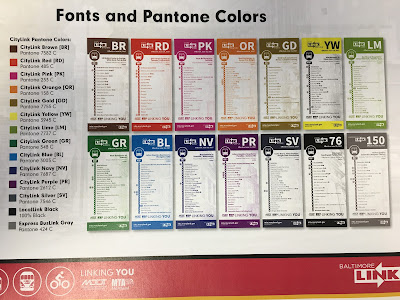 |
| New bus colors (Local Link) |
The project name was developed to emphasize how the redesigned network will provide a better connection between origins and destinations and between modes of transportation. To achieve MTA’s overarching mission of providing safe, efficient and reliable transit across Maryland with world-class customer service, the BaltimoreLink Plan has five major goals:Ever since, riders, transit advocates and politicians have wondered if the MTA can and will deliver on this complex undertaking. The roll-out of the first draft was not exactly greeted with great enthusiasm. With its emphasis on a high-frequency grid and new cross-town bus lines the system looked to transit geeks but too many actual users saw their familiar lines disappear, be moved further away, or shortened to the effect that the expected rides would be more cumbersome and possibly even slower thanks to additional walk time to the stop or wait time at a transfer point. Others didn't want a new bus stop where it was envisioned. Meanwhile, City and MTA began a great partnership on bus lanes and traffic signals. For the buses to "speak" to the signals and get priority, both, the buses and the signals needed new hardware that had to be ordered, installed and tested.
1. Improve service quality and reliability;
2. Maximize access to high-frequency transit;
3. Strengthen connections between MTA’s bus and rail routes;
4. Align the network with existing and emerging job centers; and
5. Engage riders, employees, communities, and elected officials in the planning process. (website)
 |
| bagged new sign temporary showing the old lines |
The concept plans have been run through several iterations and three rounds of public comments with a total of 1,132 registered comments. Each time, the MTA planners went back to the drawing board and tweaked the routes. Planning Director Quinn said that they "spread the peanut butter a different way", i.e. distributing a set amount of resources (buses and drivers) in different ways. The initial focus on the high frequency network gave way to increased sensibility to geographic coverage and the outcry from communities in Waverly, Dundalk and elsewhere who feared that their connections would disappear altogether. As a result many bus routes now closely resemble the old ones, even though they have new names. High frequency routes (bus comes every 15 minutes or better) will be color coded, local routes will get new numbers.
The last and final version of the route map, City-Link 3.0, will be rolled out shortly and will reflect the most recent comment period which ended on February 21. The result should make many doubters happy. There will be continued service on 33rd Street and Greenmount Avenue, Turner Station will be served and so will Brightwood College near the Cromwell Bridge Park and Ride. Very long routes will still be shorter and they will be simplified and no longer come in three or four variations (like he #10, 15 or 23 used to have), each running just a tad different so that an unsuspecting #23 user could find that he had to get off at Wildwood (the exception) instead of reaching Rolling Road (the rule).
 |
| Proposed dedicated bus lanes |
306 bus stops (6%) have already been eliminated in the most recent schedule update on February 6. About 2,500 bus stops already received a temporary "bag" (with another 200 added every week) that shows the old route while covering up the new sign underneath. (In the night of June 17 hundreds of MTA folks will spread out to take 5,000 covers off) to reveal the redesigned signs which will carry much more information than the old ones. Red bus only lanes have already been marked on Pratt and Lombard Street, additional ones including on Baltimore and Fayette Street will be added soon. Where buses will run on new routes $10,000 a piece concrete bus pads will be added because regular blacktop isn't strong enough to support the heavy buses on hot summer days. About half of the bus fleet has already the new Link Colors, one set for Local Link and the other for City Link. 250 City Link bus already have received their signal communication hardware. 36 signalized City intersections as well, testing to optimize the communication will begin shortly. New automated vehicle locator hardware has been procured and will eventually allow accurate bus count down clocks at select stops and on smart phones which tell in minutes when the bus will actually arrive.
 |
| New schedule color coded like the bus lines |
The new bus world will still come to a shock to many riders who haven't been paying attention to the 18 months of preparation and discussion. To reduce the surprise, a info bus equipped with maps, boards, schedules and MTA staff will shortly begin to run on the existing routes and will provide free rides with information specifically geared to changes on that particular route. Of course, there will be flyers, fully redesigned maps and schedules at libraries, schools and shops and online information. Anybody who wants to schedule a presentation in their community or business can request a presentation.
It can be expected that June 19 won't be entirely flawless, no matter how much work MTA has put into the preparations. There will be adjustments and tweaking, just like there was in Houston which completed a similar operation with success and added ridership. Now, after the most recent public comments have been incorporated, it is time for Baltimore to take a positive and constructive attitude which is key for a successful implementation. The enthusiasm and the energy that MTA exhibited day for day during the last 15 months speaks for success. Baltimore sure could use it.
Klaus Philipsen, FAIA
No comments:
Post a Comment